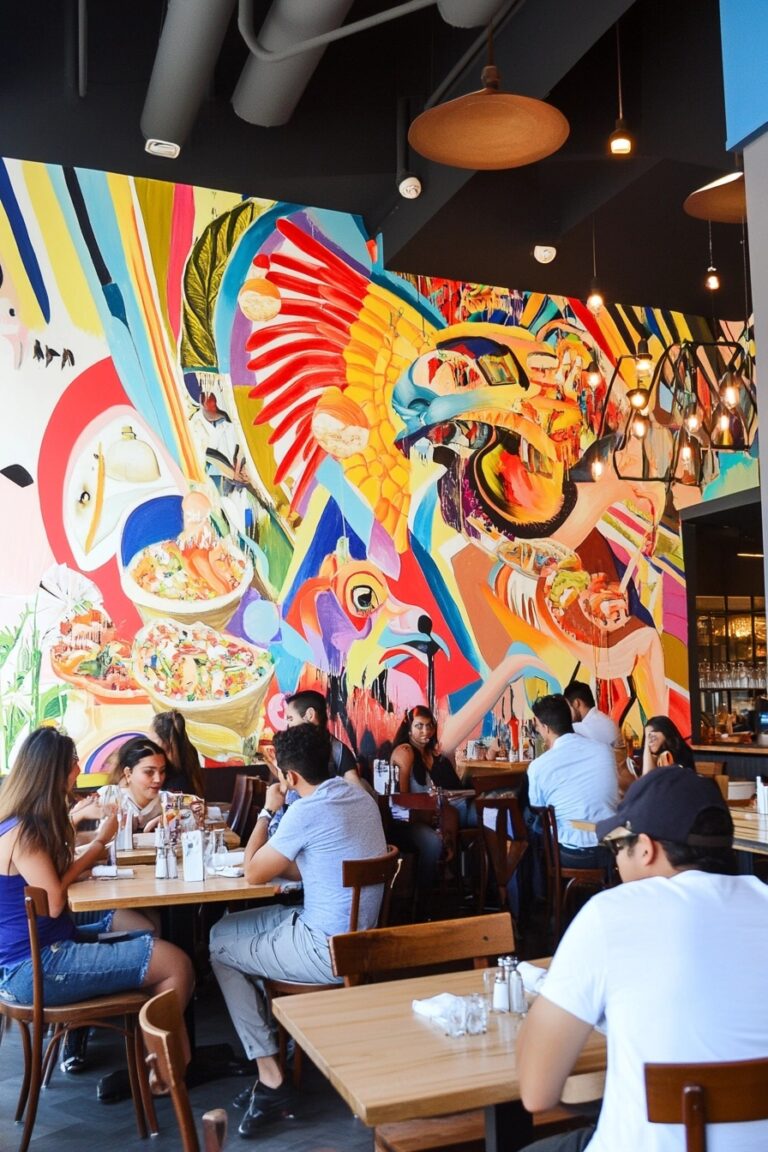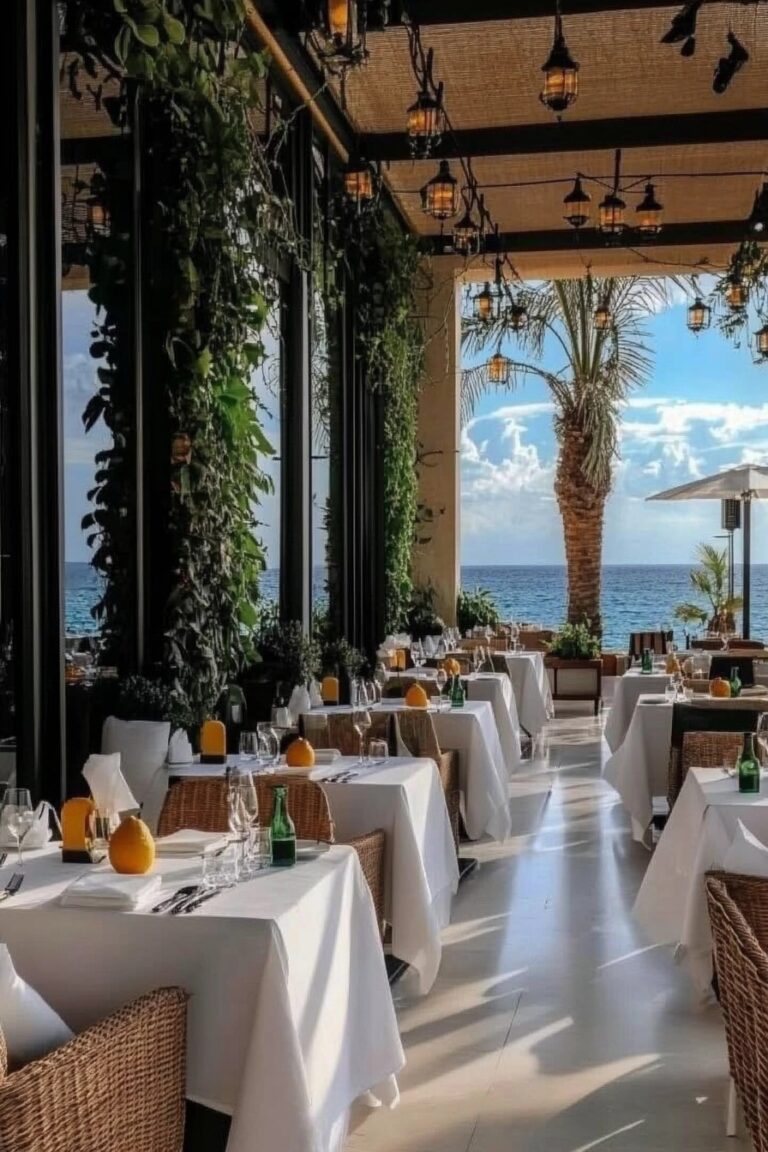Ever walk into a sushi place and just feel instantly calmer, cooler, and ready for some amazing food? It’s not just the promise of delicious nigiri; it’s that whole vibe. There’s a special magic to the sushi restaurant aesthetic – that blend of sleek design, natural touches, and quiet sophistication. Let’s unpack what makes these spaces feel so unique and why that ambiance is almost as crucial as the freshness of the fish! We’re diving into some truly stunning examples for your trip to Japan.
15 Gorgeous Sushi Restaurant Aesthetic Examples for Your Next Japan Trip
1. Peeking Through the Noren: The Welcoming Entrance
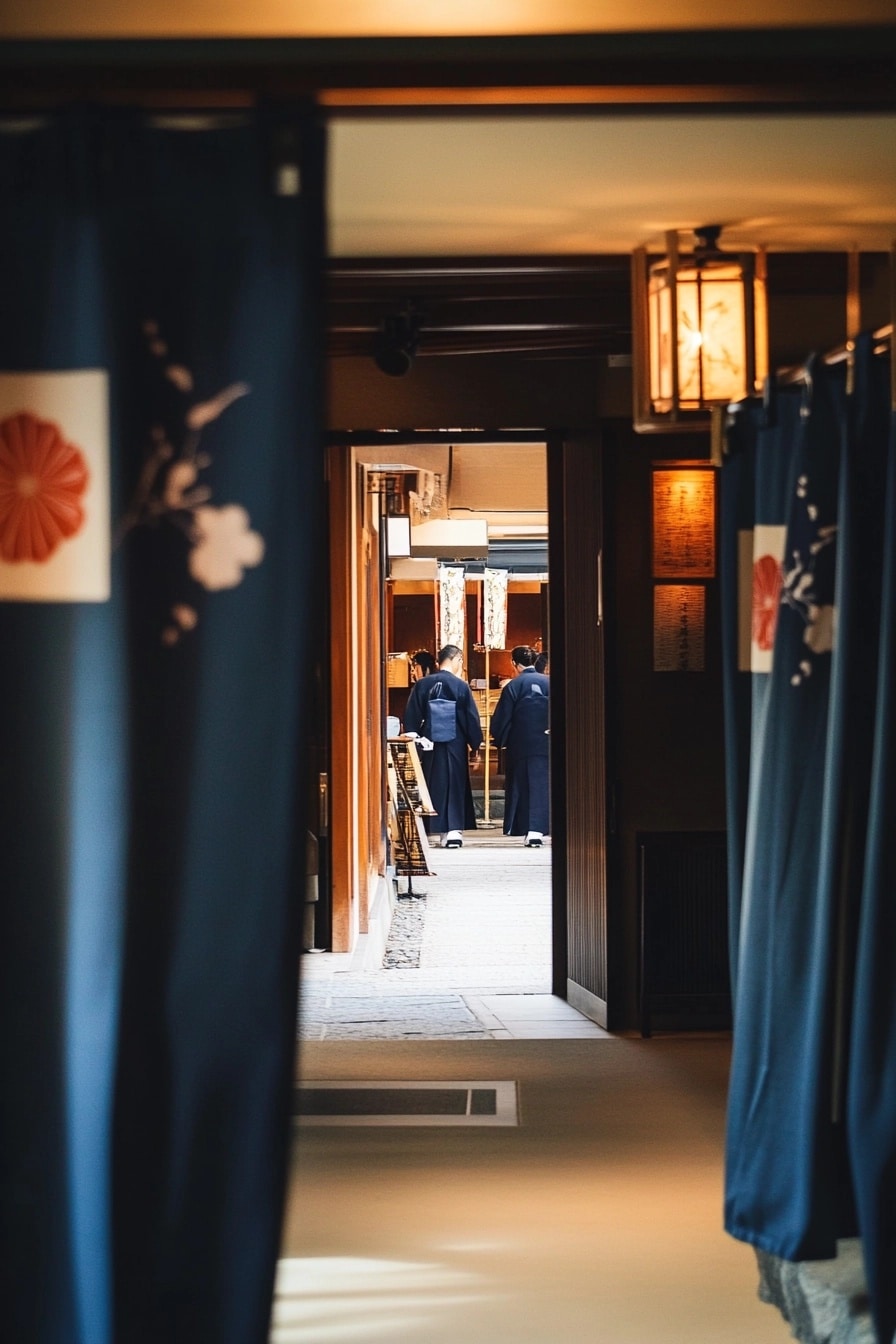
These iconic fabric dividers often mark the entrance to Japanese eateries. They offer a glimpse inside, creating a sense of mystery and anticipation for the sushi aesthetic within.
There’s something so inviting about Noren curtains, isn’t there? That moment of brushing past the soft fabric feels like stepping into another world. It’s often the very first hint of the carefully curated sushi restaurant aesthetic waiting inside. These simple dividers, often dyed indigo blue and featuring subtle crests or characters, signal authenticity and tradition. They provide a gentle separation from the bustling street, immediately lowering the noise level and setting a calmer tone for your dining experience. It’s a beautiful, functional piece of design that instantly says “Japan.”
2. Serene Sips: Matcha Moments with a View
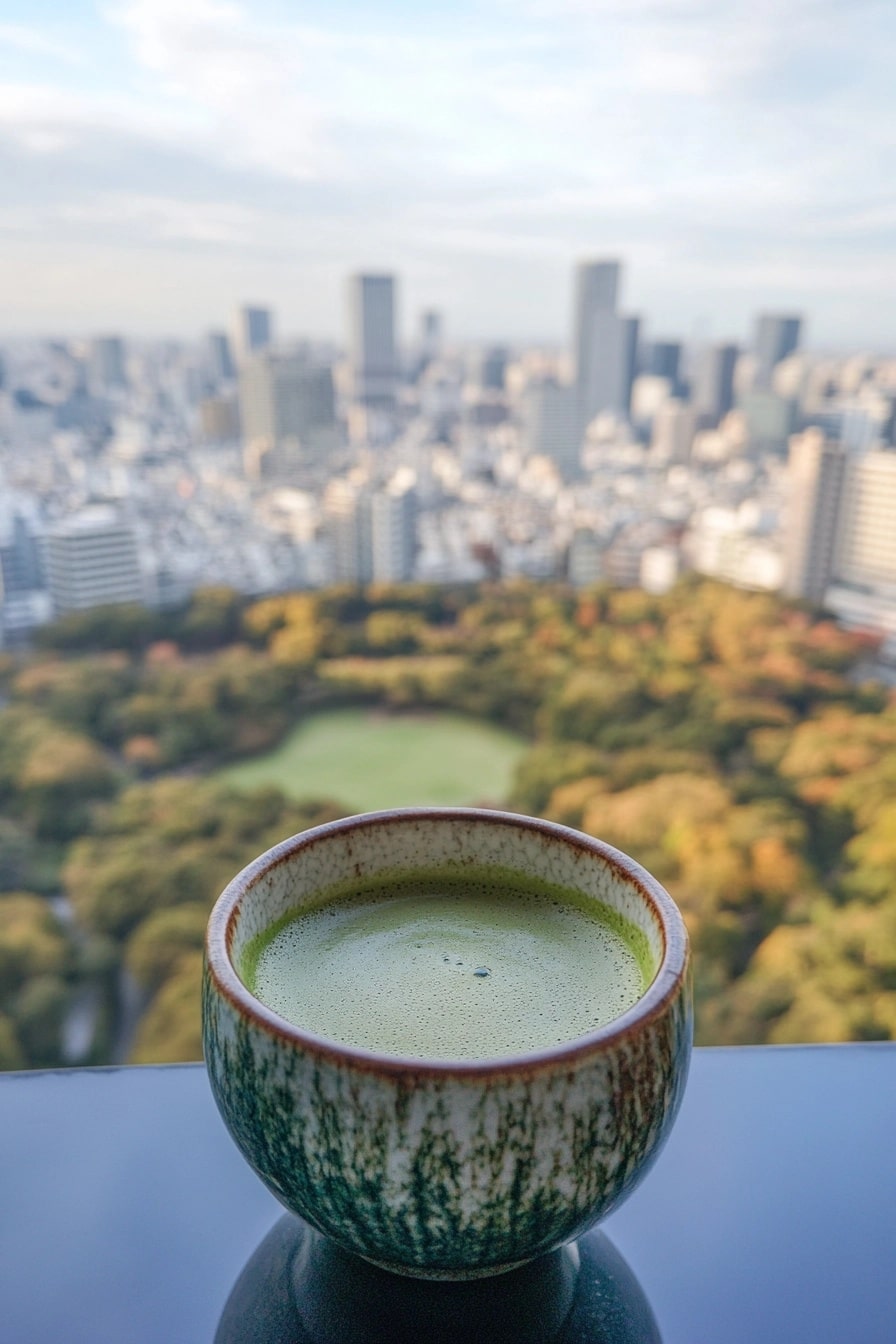
Enjoying a traditional beverage like matcha becomes even more special with a stunning backdrop. This juxtaposition of calm tradition and modern cityscape is a unique part of the Japanese dining aesthetic.
Imagine this: settling into a quiet corner, a beautifully crafted ceramic bowl of frothy matcha warming your hands, and gazing out at an incredible view. Whether it’s a sprawling city like Tokyo or a peaceful garden, incorporating the outside view is a key element in many high-end Japanese restaurant designs. It connects the serene interior with the world outside, creating a multi-layered experience. It elevates a simple tea break into a moment of mindful appreciation – perfect for a pause during your Japan trip explorations or setting the scene for an unforgettable sushi dinner aesthetic.
3. Modern Fusion: Where Neon Meets Natural Wood

Contemporary sushi shops often blend traditional materials like wood with modern elements like abstract lighting. This creates a sophisticated and visually dynamic atmosphere.
Who says traditional has to mean old-fashioned? I absolutely love how contemporary Japanese designers play with contrasts. Think sleek, dark wood panels intertwined with sharp, geometric lines of warm neon or LED lighting. It’s unexpected, sophisticated, and incredibly cool. This approach respects traditional materials while injecting a vibrant, modern energy perfect for a stylish sushi night aesthetic. It proves that minimalism doesn’t have to be boring; it can be bold and artistic, creating a truly memorable backdrop for your meal.
4. Dramatic Flair: Sushi Served with a Cloud of Mystery
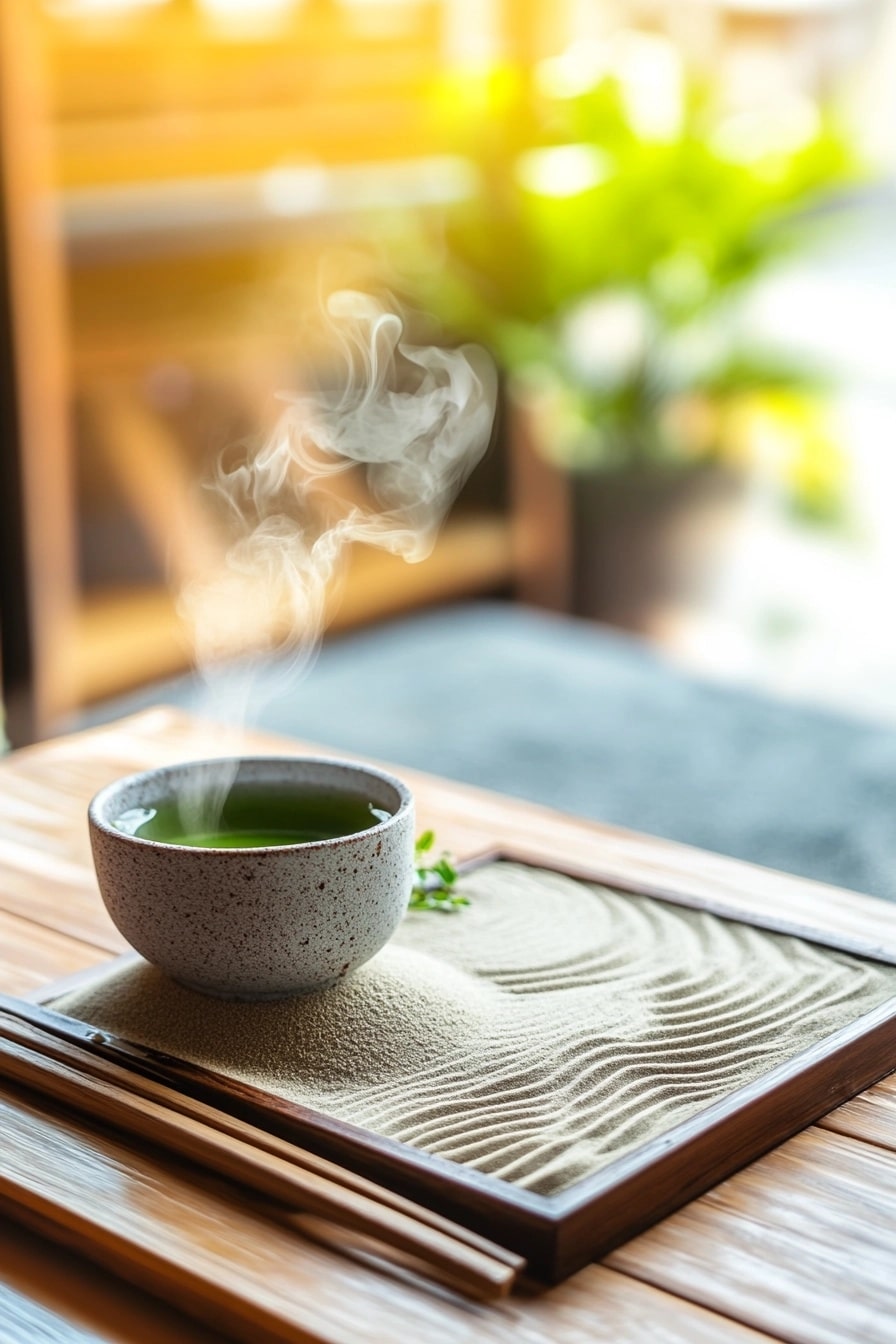
Presentation is key in Japanese cuisine. Using elements like dry ice adds a touch of theatricality and excitement, making the eating sushi aesthetic even more Instagrammable.
Okay, talk about making an entrance! Seeing your sushi arrive enveloped in a mystical cloud of dry ice smoke is pure culinary theater. It’s not just about taste; it’s about the entire sensory experience. This kind of dramatic presentation instantly elevates the meal, making it feel special and exciting – definitely something you’ll want to capture for your Sushi Aesthetic Instagram feed! While not every sushi restaurant does this, finding one that embraces such creative flair adds an extra layer of fun and memorability to your dining adventure in Japan. It shows a commitment to delighting all the senses.
5. Tabletop Tranquility: Mini Zen Gardens & Tea
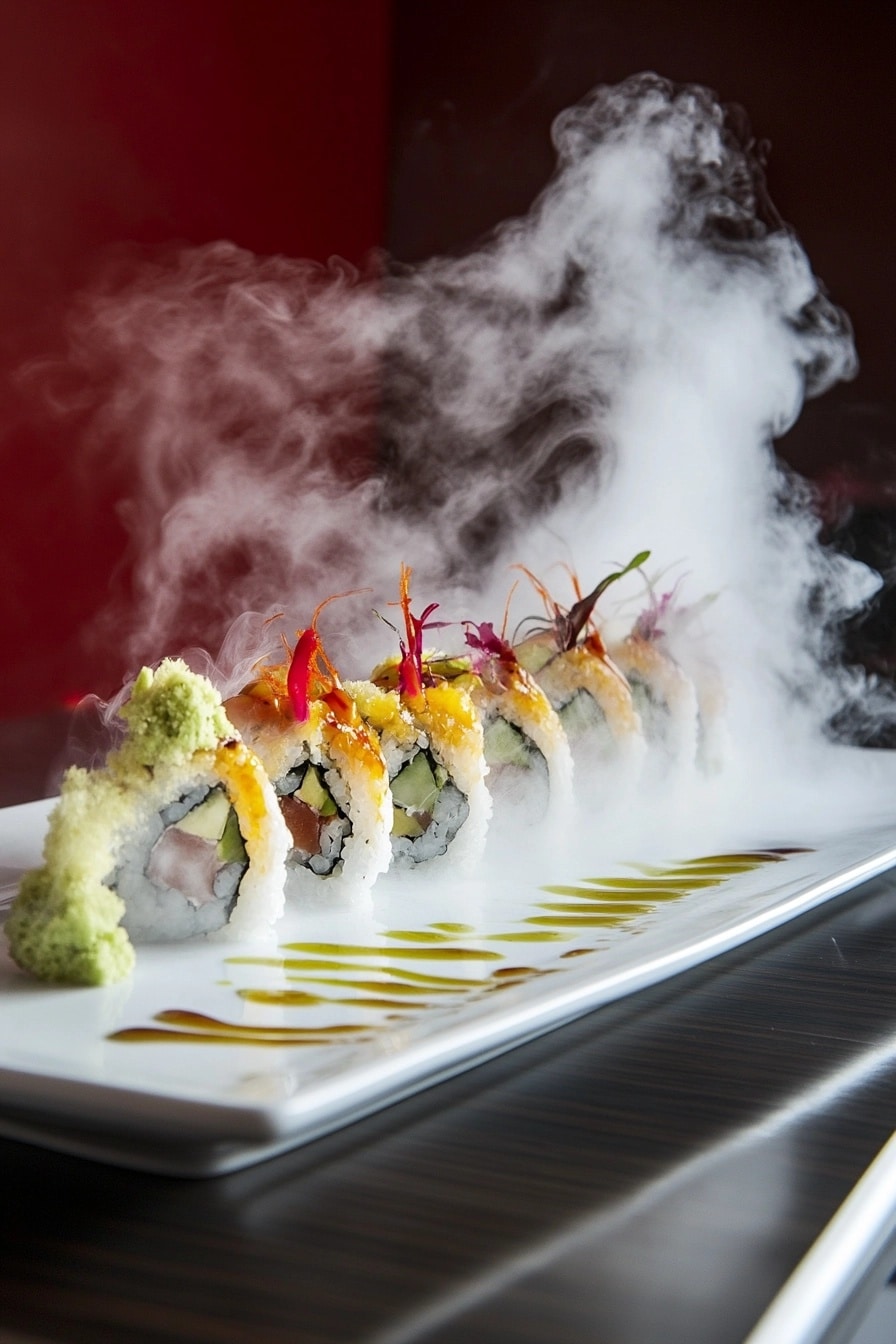
Incorporating elements of Japanese gardens, like miniature zen gardens, directly onto the table enhances the calming and mindful atmosphere central to the sushi restaurant aesthetic.
It’s the little details that truly define an atmosphere. Imagine sitting down and finding not just your chopsticks and soy sauce dish, but a tiny, perfectly raked zen garden right there on your table. It’s an immediate invitation to slow down, breathe, and appreciate the moment. Paired with a steaming cup of delicate green tea, it transforms your table into a miniature landscape of tranquility. This small touch perfectly encapsulates the Japanese reverence for nature and mindfulness, weaving it seamlessly into the eating sushi aesthetic. It’s calming, beautiful, and utterly charming.
6. Focus on Freshness: The Art of Plating Uni
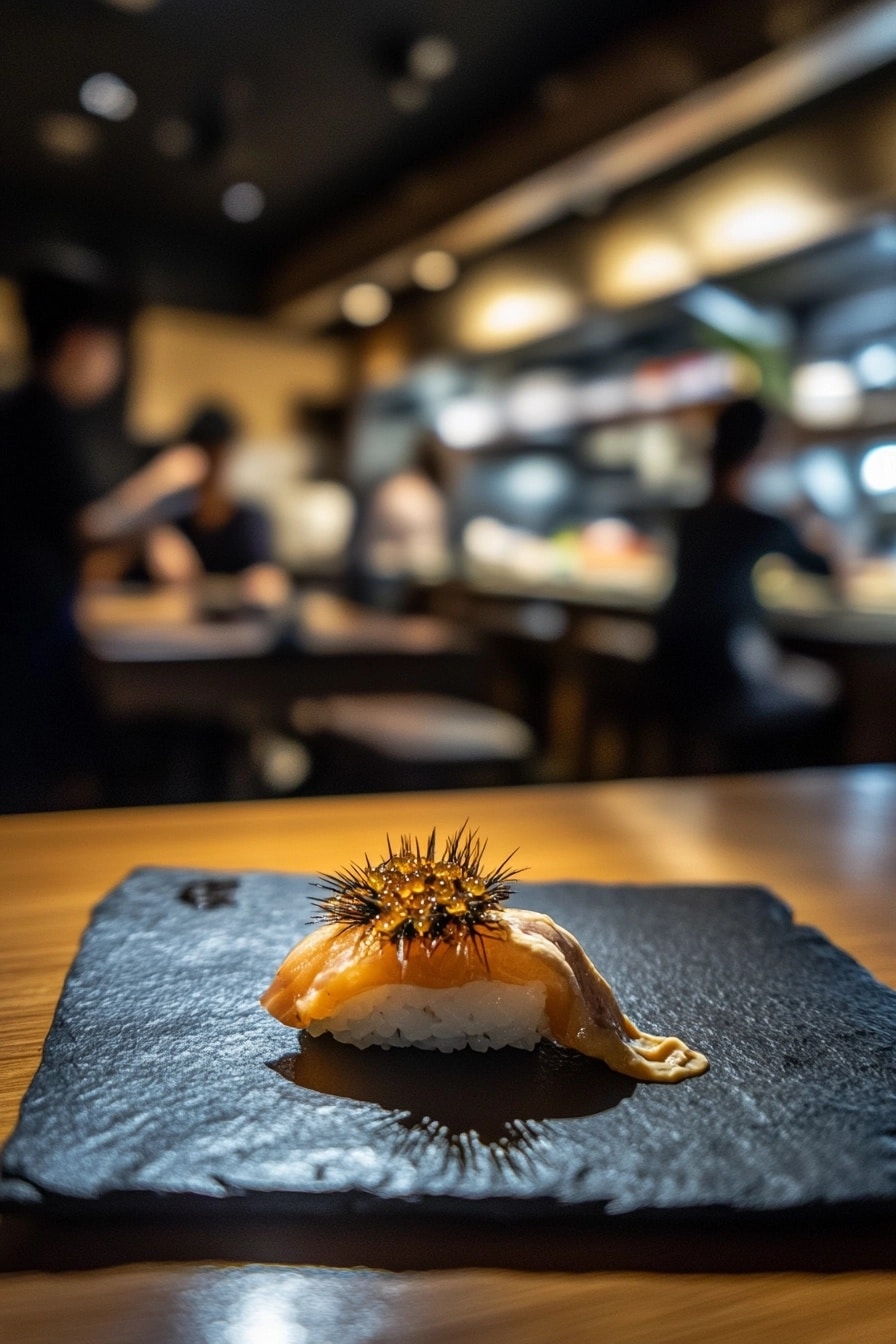
Minimalist plating on natural materials like slate emphasizes the quality and freshness of prized ingredients like uni. The focus is entirely on the food itself.
Sometimes, the most impactful aesthetic is simplicity itself. Look at how this single piece of uni sushi is presented – it’s the undeniable star. Served on a simple, dark slate plate, its vibrant colour and glistening texture are highlighted. Even including the spiky shell adds a touch of the wild ocean it came from. This kind of minimalist plating is a hallmark of high-quality sushi restaurants. It speaks of confidence in the ingredients and allows the natural beauty and freshness of the seafood to take center stage. It’s a visual promise of the incredible flavour to come.
7. Fiery Spectacle: The Energy of Open Grill Yakitori
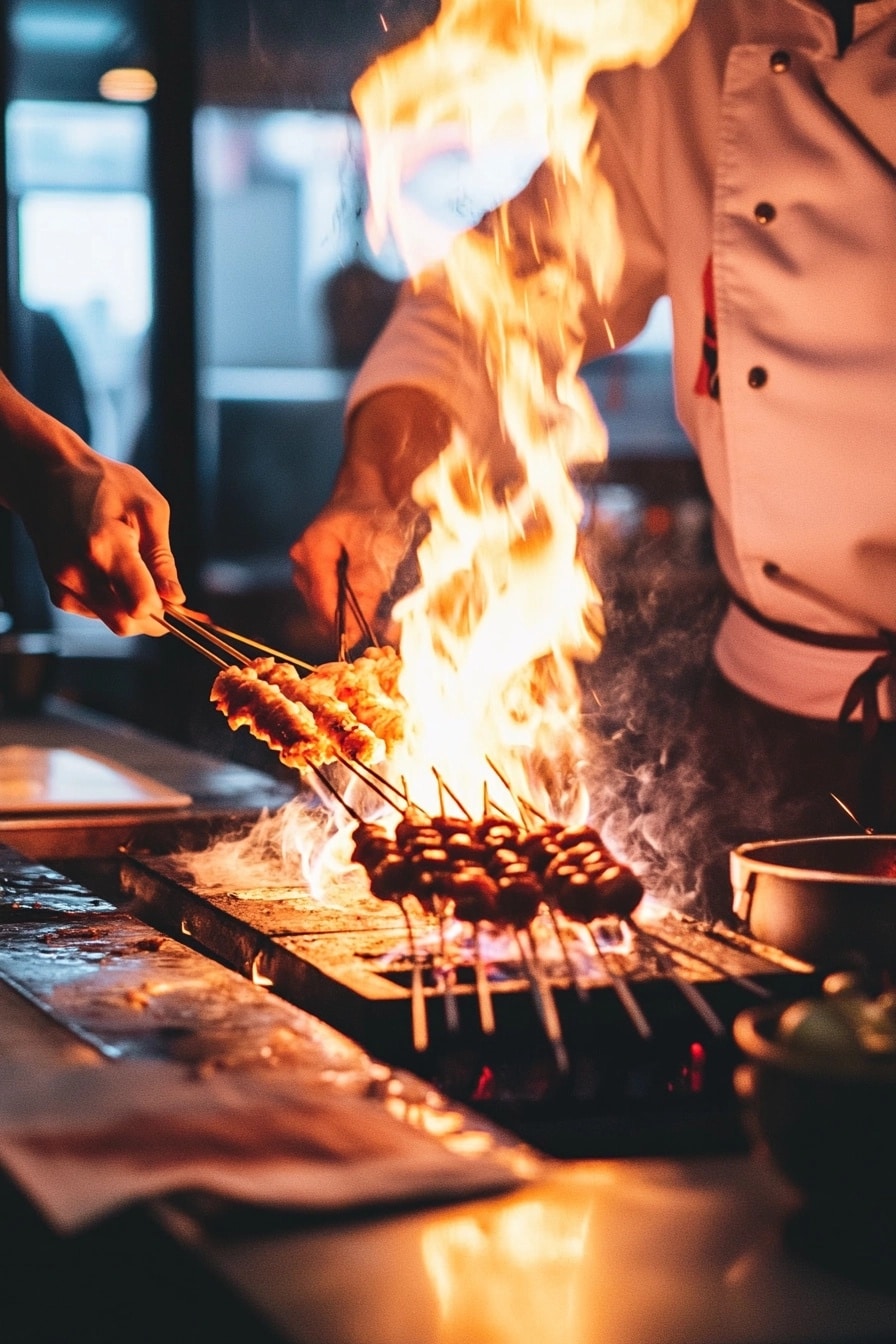
While not strictly sushi, many Japanese eateries feature open grills. The sight and sound of yakitori being grilled over flames add an energetic, smoky element to the dining experience.
While we’re focused on the sushi restaurant aesthetic, let’s not forget the other captivating culinary experiences Japan offers! Many izakayas (Japanese pubs) or restaurants feature open grills where chefs expertly prepare yakitori (grilled skewers). Watching the flames leap up as the skewers sizzle and smoke is incredibly mesmerizing! It adds a dynamic, energetic counterpoint to the often calmer sushi bar vibe. The delicious smoky aroma filling the air, the sound of the grilling, the chef’s focused movements – it’s a feast for the senses before you even take a bite. It’s raw, exciting, and totally captivating.
8. Culinary Theater: The Mesmerizing Art of Aburi
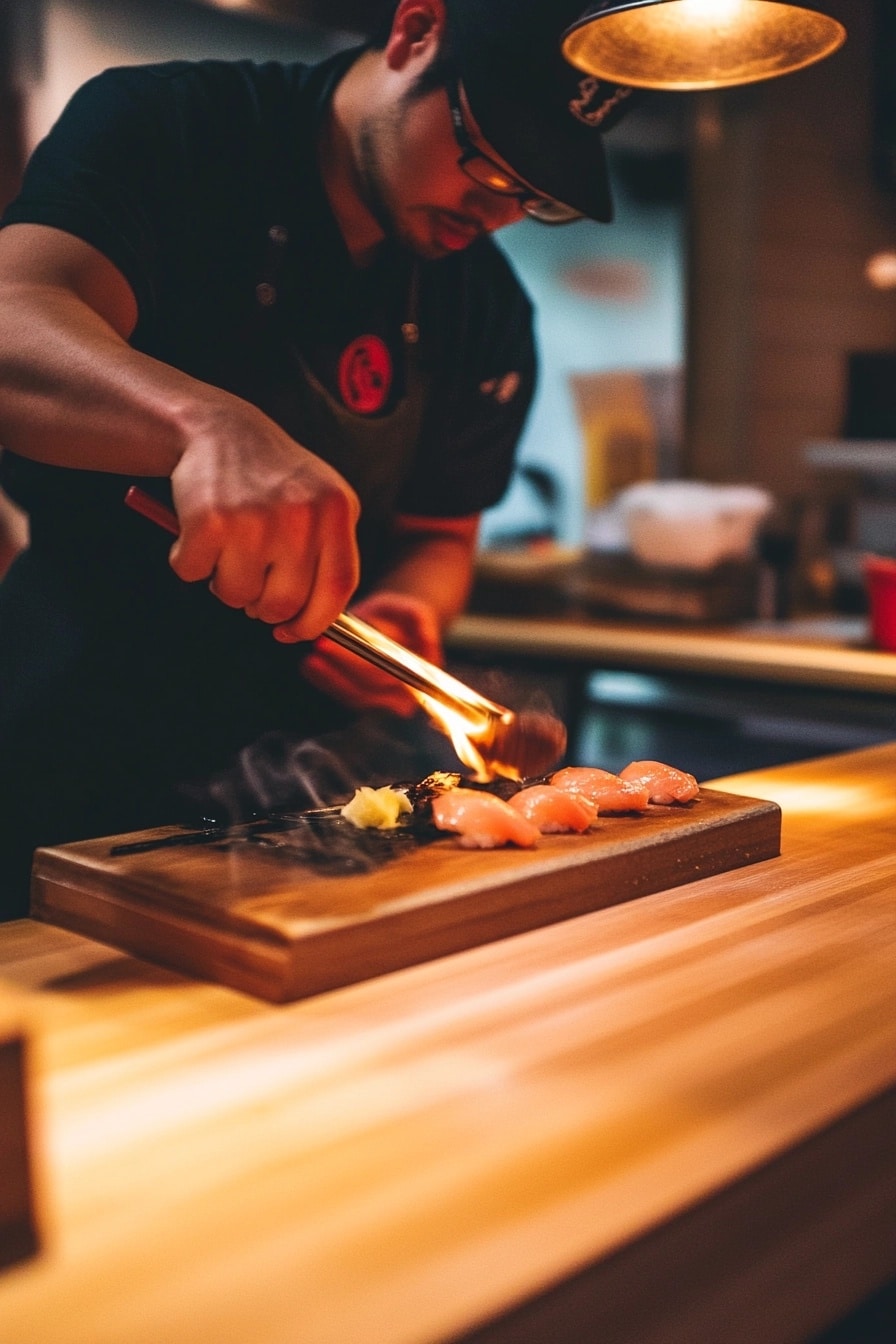
Aburi-style sushi involves lightly searing the fish, often with a blowtorch right before serving. Watching this process adds an element of culinary performance to the sushi bar experience.
Sitting at the sushi bar offers front-row seats to incredible craftsmanship, and watching a chef prepare aburi sushi is a highlight. Aburi means ‘flame-seared,’ and seeing the chef expertly wield a blowtorch, lightly caramelizing the top of the fish just before it’s served, is fascinating. The intense heat releases amazing aromas and adds a subtle smoky flavour and textural contrast to the sushi. It’s a moment of controlled fire and precision, transforming the ingredient right before your eyes. This touch of culinary theatre is a fantastic part of the interactive sushi bar design and experience.
9. Edible Art: When Sushi Becomes a Canvas
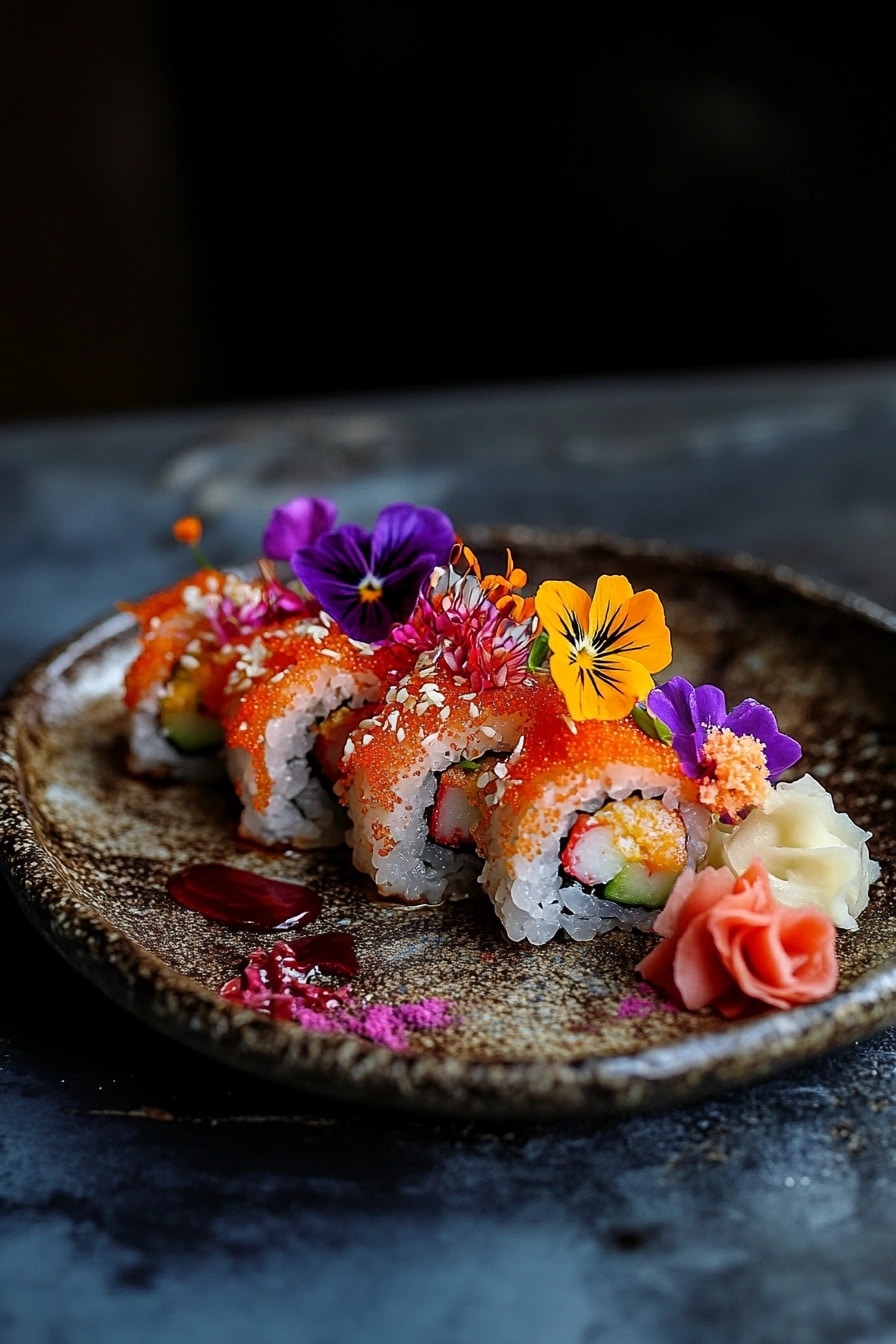
Modern sushi often incorporates artistic elements like edible flowers and intricate sauce designs. This turns the food itself into a key part of the visual sushi aesthetic.
Isn’t this just stunning? Sometimes sushi transcends food and becomes pure art. Look how these vibrant edible flowers and delicate drizzles of sauce transform a simple sushi roll into a masterpiece. Plated on a beautiful, textured ceramic dish, it’s almost too pretty to eat… almost! This level of artistry reflects the deep respect for ingredients and aesthetics in Japanese culture. It makes the dining experience feel incredibly special and is perfect inspiration for anyone wanting to capture that perfect Sushi Aesthetic Instagram shot. It’s a reminder that beauty can be found in every detail.
10. Dinner with a Dazzling View: City Lights & Sushi Nights
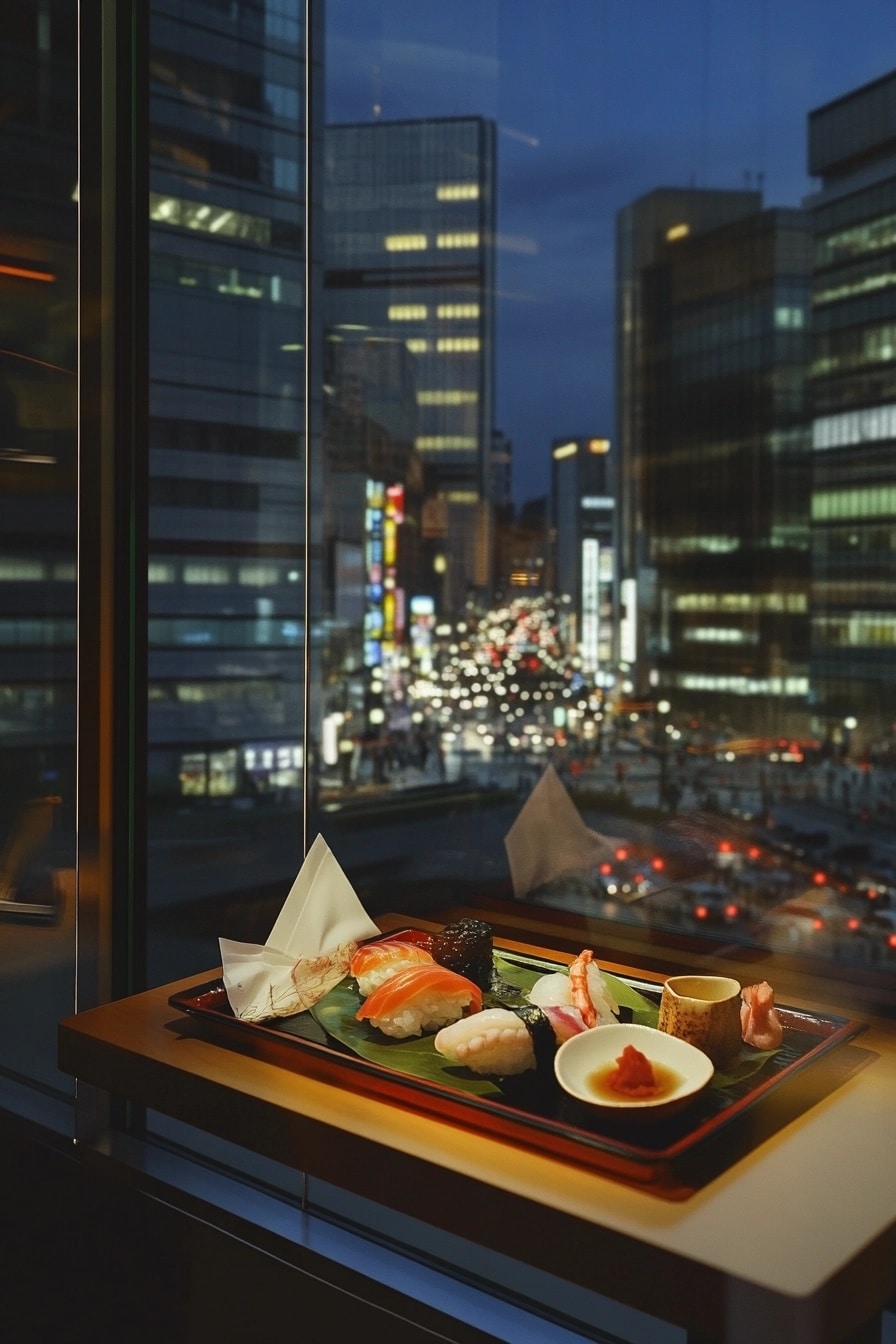
Enjoying a sushi dinner aesthetic is enhanced by a dramatic nighttime city view. The sparkling lights create a sophisticated and memorable backdrop for your meal.
There’s a unique magic to dining high above a glittering cityscape, especially in a vibrant metropolis like Tokyo. Pairing exquisite sushi with panoramic views of twinkling lights creates an atmosphere that’s both incredibly sophisticated and excitingly urban. It’s the perfect setting for a special sushi date or a memorable sushi night aesthetic with friends. The contrast between the calm, curated interior and the dynamic energy of the city outside makes for an unforgettable dining experience. Many modern sushi restaurants in Japan cleverly utilize their location to offer these breathtaking views, making the ambiance as much a draw as the food itself.
11. Lantern Glow: Soft Lighting for Sushi Ambiance
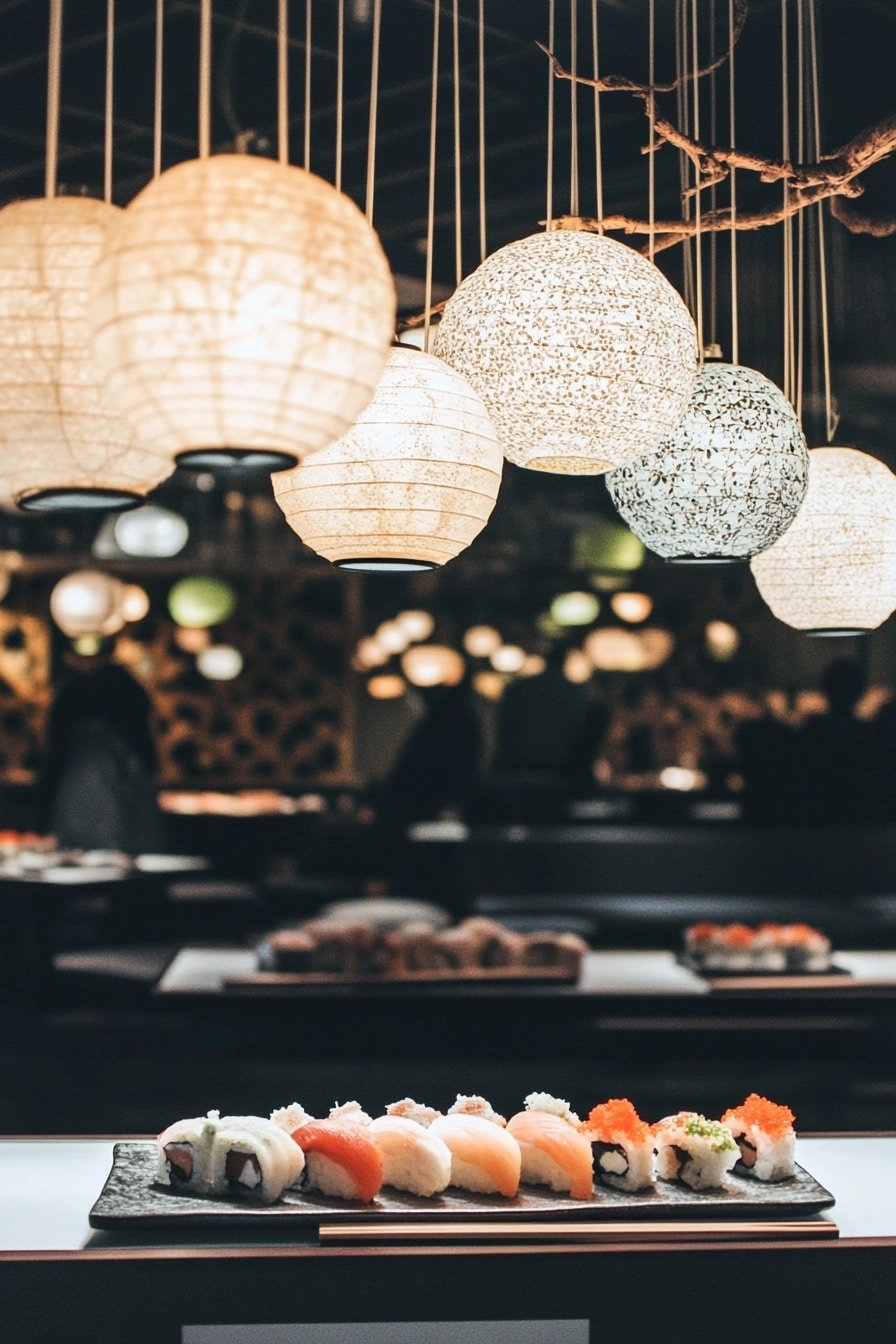
Soft, warm lighting from traditional paper lanterns or modern equivalents is crucial for creating an inviting sushi dinner aesthetic. It sets a calm, intimate mood.
Lighting plays such a huge role in setting the mood, and Japanese design masters this art beautifully. Clusters of hanging lanterns, whether traditional washi paper or more modern textured ceramic designs, cast a soft, warm, and inviting glow. This ambient lighting is key to the cozy yet sophisticated sushi restaurant aesthetic. It avoids harsh overhead lights, creating intimate pools of light over tables and the sushi bar, encouraging relaxed conversation and focusing attention on the beautiful food. It feels gentle, calming, and perfectly suited for enjoying delicate flavours.
12. Master at Work: The Precision of a Sushi Chef
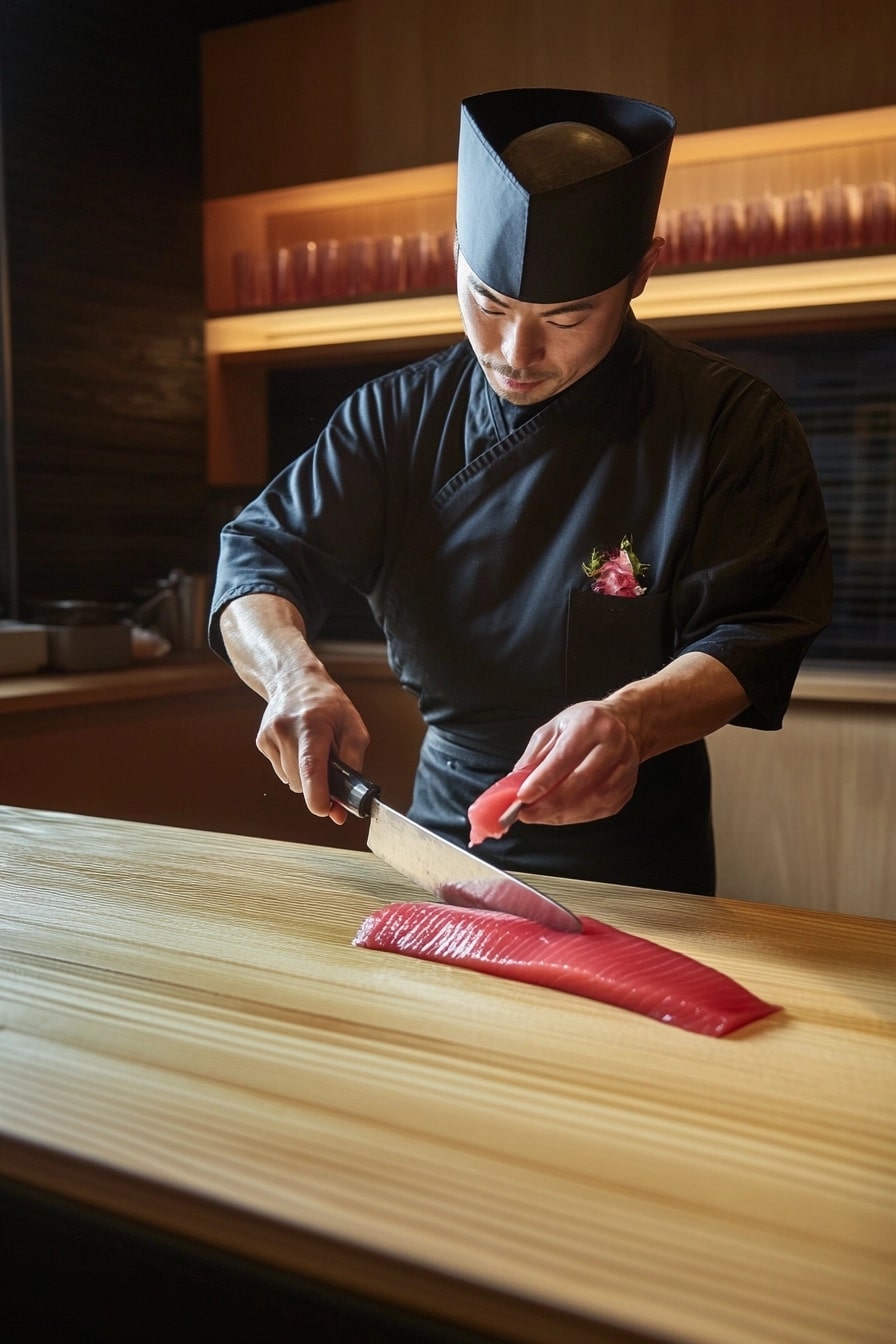
Watching a skilled sushi chef work is part of the experience. Their precision, focus, and expert knife skills are central to the authenticity of a great sushi bar design.
One of the most captivating parts of the sushi experience, especially if you snag a seat at the counter, is watching the chef. There’s a quiet intensity and incredible precision in their movements. Seeing them expertly wield a long, sharp sushi knife (yanagiba) to slice a perfect piece of glistening tuna is like watching a practiced art form. It highlights the years of training and dedication required. This focus on craftsmanship is a core element of the sushi restaurant aesthetic – it’s not just about eating; it’s about appreciating the skill that goes into preparing each piece. It’s pure respect for the craft.
13. A Bowl of Jewels: The Beauty of Chirashi
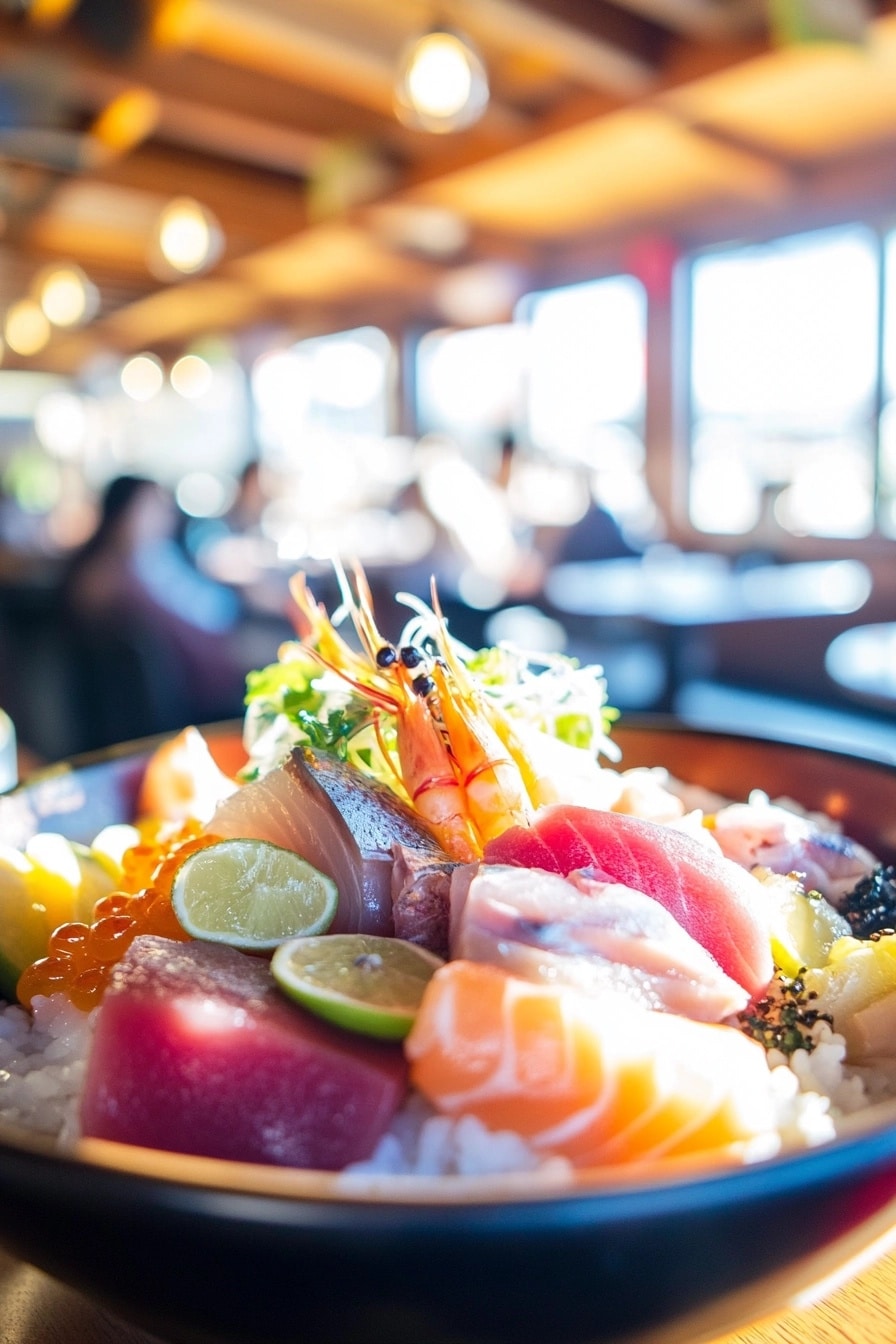
Chirashi sushi, meaning “scattered sushi,” is a visually stunning dish. The colourful assortment of fresh seafood arranged over rice makes for a beautiful eating sushi aesthetic.
Forget neat rows for a second and embrace the beautiful chaos of Chirashi! This “scattered sushi” is a feast for the eyes before it even touches your lips. A generous bowl of perfectly seasoned sushi rice adorned with a vibrant tapestry of assorted sashimi, gleaming fish roe, perhaps some sweet tamago (egg omelet), and garnishes – it’s like discovering a treasure chest of oceanic jewels. The sheer variety of colours and textures makes it incredibly appealing and a fantastic representation of the fresh, bright eating sushi aesthetic. It’s often a great value option for lunch in Japan, too!
14. Street Food Vibes: Yakitori Under Lantern Light

While distinct from a formal sushi restaurant, the aesthetic of Japanese street food stalls, with their glowing lanterns and focused chefs, shares a similar atmospheric charm.
Stepping away from formal dining, the aesthetic of Japanese street food stalls, particularly at night, is equally captivating. Imagine wandering through a narrow alleyway (a *yokocho*), guided by the glow of red paper lanterns advertising delicious yakitori or ramen. Chefs work diligently in small, open kitchens, steam rising into the cool night air. While maybe not the refined sushi shop vibe, there’s an undeniable energy and authenticity here that’s incredibly appealing. It’s a more casual, bustling aesthetic, but shares that same focus on dedicated preparation and inviting light.
15. Kanpai! Sharing Moments Over Sake and Sushi
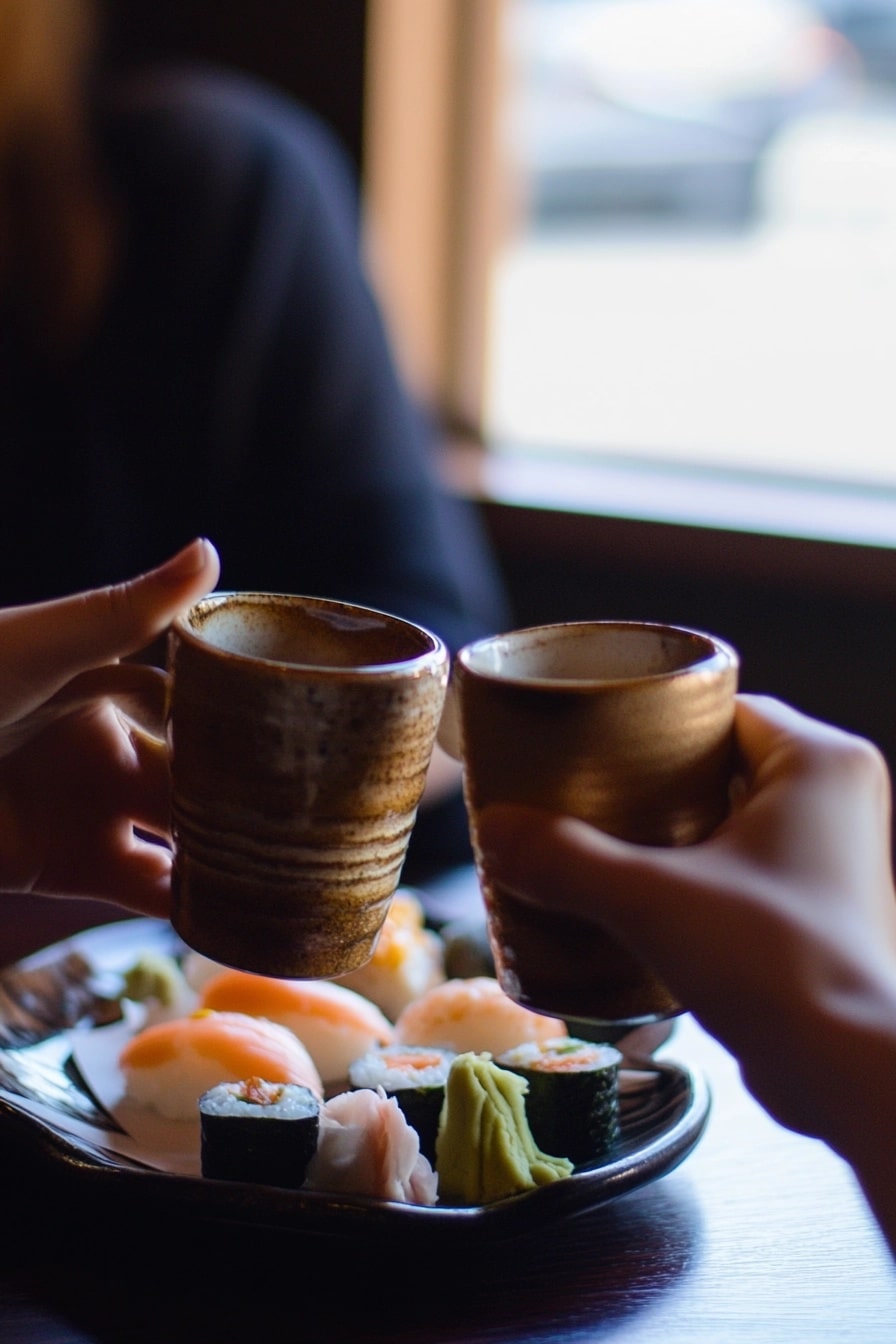
The social aspect is key to the sushi night aesthetic. Sharing sake and platters of sushi with friends or a partner creates warm, memorable moments. Kanpai! (Cheers!)
Ultimately, the best sushi restaurant aesthetic facilitates connection. Whether it’s an intimate sushi date or a lively gathering with friends, sharing food and drinks is central to the experience. That satisfying clink of ceramic sake cups (“Kanpai!”), reaching across the table to share a particularly delicious-looking roll, the easy flow of conversation in a comfortable setting – these are the moments that make a meal truly special. A great sushi place provides the perfect backdrop for creating these happy memories, blending delicious food with an atmosphere that encourages warmth and togetherness.
Frequently Asked Questions About Sushi Restaurant Aesthetic
Q1: What defines the typical Sushi Restaurant Aesthetic?
A1: The typical Sushi Restaurant Aesthetic often blends Japanese minimalism with natural elements like wood, bamboo, and stone. Expect clean lines, uncluttered spaces, subtle, warm lighting, and an emphasis on craftsmanship, creating a calm, sophisticated, and focused atmosphere.
Q2: What are some key elements for great Sushi Bar Design Ideas?
A2: Great Sushi Bar Design often centers the sushi chef’s counter as a focal point, using materials like light wood or smooth stone. Comfortable, simple seating, ambient or focused lighting over the bar, and touches of Japanese-inspired decor (like Noren curtains or simple pottery) are key elements that enhance the experience.
Q3: How does the restaurant aesthetic impact a Sushi Date or Sushi Night experience?
A3: The right aesthetic significantly enhances a Sushi Date or Sushi Night by setting a specific mood – often intimate, calm, and refined. This intentional atmosphere encourages conversation, allows appreciation for the food’s artistry, and turns the meal into a more memorable, sensory experience beyond just eating.

